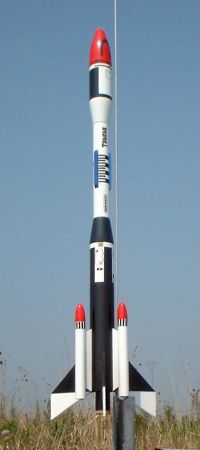| Construction Rating: | starstarstarstarstar_border |
| Flight Rating: | starstarstarstarstar |
| Overall Rating: | starstarstarstarstar |
| Diameter: | 1.34 inches |
| Length: | 23.50 inches |
| Manufacturer: | Semroc  |
| Skill Level: | 1 |
| Style: | Clone, Futuristic/Exotic |

Brief:
While most Semroc Retro-Repros offer slightly modernized versions of Centuri
classic designs, Semroc goes "old school" on Centuri, replacing the
"innovative" plastic cones and transitions of the 1972 KB-3 Taurus
with good old-fashioned balsa parts. This is a futuristic design very nicely
done.
Construction:
Given that the previous reviewer made his from assorted spare parts, it must
have cost a small fortune compared to the $25 retail for the now released kit
version.
This kit comes packed with plenty of parts, all of which are typical Semroc--excellent quality and true to the original Centuri dimensions. The parts list includes:
- 4 balsa nose cones
- 2 balsa transitions
- 2 body tubes
- 1 payload bay
- 3 pod tubes
- 18mm motor mount, centering rings, and metal clip
- laser-cut balsa fins
- Kevlar® and elastic shock cord
- 12" plastic chute
- waterslide decals
The instructions are laid out in 29 steps with good illustrations and plenty of tips along the way. For example, before even beginning construction you are presented with a decision about how to finish the model. If you want to use the "standard" color scheme, you should paint the subassemblies as you go. Otherwise, you can assemble everything and then paint a less complex scheme.
The first stage of production is fin preparation. The laser cutting is a nice modernization, saving the time to cut by hand. There are also instructions for sealing and filling the grains for the builder who wants a beautiful finish rather than rushing out for a same day flight.
The motor mount assembly is a fairly typical 18mm tube with engine block and metal clip, however, in addition to a pair of cardboard centering rings, it includes a section of coupler stock for a much stronger mount.
The lower body is a little more complex than the typical 3FNC kit. You start by marking the body tube for 6 bond lines using a marking guide. I prefer a wraparound guide and printed one out using Peter Kerckhoff's Fin Guide Visual Basic program. In addition to the 3 main fins, you also need to bond 3 pods mounted on small braces. Each of the 3 pods are topped off with balsa nose cones.
The upper body consists of a balsa transition, body tube, another balsa transition (reducer), payload bay, and balsa nose cone. There are also 3 trim "tunnels".
Finishing:
I went for the more ambitious "standard" color scheme, which involved
a lot of painting of subassemblies along the way. I also spent a good hour or
two applying a small bead of Elmer's Wood Filler to the tube spirals then
sanding it down all before doing any of the bonding.
In my case, the main body tubes (with bonded fins) and transitions were all painted with two light primer coats followed by two coats of gloss white. Then, the lower body tube and fins were masked off for a coat of gloss black. The roll pattern was especially tricky, and I'm very surprised this was not supported by a decal.
The lower transition also got a coat of gloss black and the payload bay got a black roll pattern (another good situation where a decal would have been helpful). The side pods were painted gloss white and all of the nose cones were painted a red (stock calls for orange, but my orange would have looked too pumpkin-like instead of a fiery red/orange). As a finishing touch, I masked off the tunnels on the upper body and painted them blue. All told, the paint scheme involved 4 colors applied over the course of 7 days, allowing for dry time.
There are plenty of nice waterslide decals (although sadly no roll patterns), which are applied mainly as trim.
Construction Rating: 4 out of 5
Flight:
For the first flight, I had a relatively calm 5-6mph wind day, so opted to go
for the gusto with a C6-5. The flight was straight up and not even a trace of
spin. Deployment was perfectly timed at 5 seconds.
I flew it again a couple weeks later in stiffer winds (10-12mph steady) on a B6-4. It weathercocked just slightly, yet still deployed right at apogee. You really can't ask for better flight performance. I didn't note the altitude, but the drift was roughly 75 yards.
Recovery:
The 12" plastic chute and Kevlar®/nylon
cord combination worked fine. I'll note that Semroc uses some of the best tape
disks I have encountered.
Flight Rating: 5 out of 5
Summary:
For a modroc in the 18mm class, this is a fairly complex design (but not
necessarily complex to build). It is certainly interesting looking.
I have no cons for this. Any attempt to do so would come across as overly picky. You'll just have to pick up one of these and come up with your own cons.
Overall Rating: 5 out of 5
Other Reviews
- Semroc Taurus By Bill Eichelberger
Brief: While not an official Semroc product, I consider this a Semroc bird because it uses all their parts, balsa included. The only non-Semroc parts I used were the Kevlar, elastic, and engine hook. The rocket strays a bit from the original by using balsa cones and transitions, but builds nicely into a faithful reproduction of the legendary Centuri kit. Construction: The kit ...
 |
 |
Flights
 |
 |